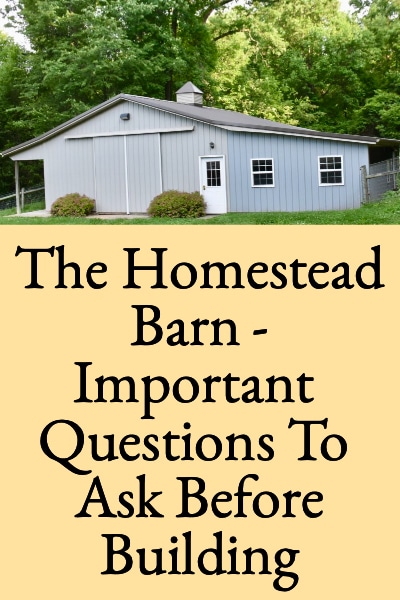
What To Consider When Planning The Homestead Barn
Take time to really research any requirements you may face on your property. And as with any building project, go above and beyond in your material and labor estimates. You’ll have a more enjoyable project if you budget a generous overage for both your money and time to build.
In addition to time and money, important aspects to plan include the location, barn type, size, flooring material, livestock accommodations, feed storage, manure handling, electricity, and water.
We could have done a better job of planning, so below are some ideas to think about and the lessons we learned.
Location, Location, Location
Deciding on the location of the barn is one of the first and most critical decisions to make before building it. Ideally, it will be located so that it’s airy, easily cleaned, comfortable for you and your livestock, warm in the winter, and cool in the summer.
A barn should be sited so that it stays dry, drains well (consider thawing spring snow and rain), has easy equipment access, and is conveniently located near the house. A structure near the house is preferable because you will hopefully be making many enjoyable trips there. However, be sure to check local ordinances because some require a minimum distance between animal housing and habitable buildings. We initially considered locating the barn a lot further from the house, and I’m so thankful that we located it only about 60′ away – it’s really so convenient and pleasant to visit.
If running water and electricity are features you want, make sure you can get them to your barn location. Also take advantage of available light, breezes, and shade to help stabilize temperatures year-round in the barn.
If the barn will be used to house livestock, then it needs to be located so that it protects the animals from drafts but can be well ventilated. Even in the coldest areas of the United States, most mature livestock can tolerate cold winter temperatures if they are dry and protected from the wind. But ample ventilation is necessary so that ammonia fumes (from urine in the bedding) don’t cause the animals respiratory problems. It’s also a good idea to locate the structure downwind from any prevailing winds that pass by the house to minimize odors and noise.
Homestead Barn Size & Style
A frequent and costly mistake that homesteaders and farmers make is not building a barn big enough to accommodate all their needs. You can readily observe this just by taking a drive through the countryside and noting how many barns and farm outbuildings have an addition or multiple additions. Also, although there are many different barn types that are popular (scroll down to links to the most popular barn types) those with a second story for storage are more cost-effective. Initially, it may seem less costly to erect a single-story barn but having a second story for storage can nearly double the available barn space.
Be careful to plan for a barn large enough to house all the equipment and animals you intend to own, plan it with future expansions in mind, and be prepared to accommodate a growing livestock herd over time. Don’t forget to plan enough stalls or pens to separately accommodate males, females, and babies of whatever different livestock animals you may want to acquire. Remember that intact males are often housed separately from females, females giving birth benefit from individual pens, and weaned babies need separate pens too.
You should plan to store the things like hay and bedding that are needed for animal care. Also, consider a wash bay for cleaning animals, a tack room to protect leather goods from dust and moisture, and a dedicated feed storage room. Equipment storage planning should include things like a tractor, tractor implements, livestock trailer, lawn tractor, utility vehicle, and any other equipment specific to your farming plans.
If milking is a possibility, then a milking parlor should be evaluated. Depending on your state and local laws, there are various regulations on how milk must be handled if it’s going to be sold for animal or human consumption or for the production of non-edibles (like soap). The rules surrounding milk and its handling need to be reviewed when designing a barn for any animals you intend to milk. Some states require that any milk for sale must be processed in a Grade A dairy. This may mean that hot water and bathroom facilities are required in the barn.
Our barn was originally 28′ x 36′, and when it was built, I never imagined that we’d outgrow it. However, with many dairy goats, goat milking, a tractor, utility cart, livestock trailer, lawn tractor, numerous tractor implements, the need to store hay/grain, and the need to process honey; we talked a lot about adding another barn.
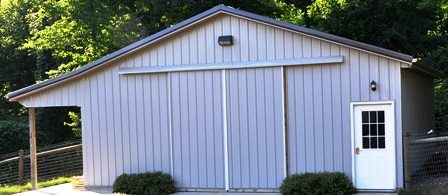
Bramblestone Farm Original Barn – Front
But, as you can see from the photos in this post, in the end, we went with a 10′ x 28′ and then a 16′ x 46′ addition to the original barn. It’s more economical to add on, we like the location of the original barn, and there’s already electricity and water. Much of the addition is used for processing honey, but there is also new housing for the goat bucks and more equipment storage.
When planning a homestead barn, put lots of thought into how many vehicles, implements, livestock, etc. you might eventually acquire. It’s amazing how things accumulate, so make the barn much bigger than you ever imagine you’ll need!
Flooring Material
The standard choices for barn flooring material are concrete or dirt. Each has advantages and disadvantages depending upon the intended use of the space.
Dirt floors are inexpensive but are not very sanitary. Livestock animals have been milked on dirt floors for centuries, but many state and local codes will not permit milking on a dirt floor if the milk is to be sold for human consumption. Concrete is a lot easier to clean and therefore more sanitary, but if you are housing animals it doesn’t soak up urine like a dirt floor. Also, large animals like horses can compact dirt flooring so much that it acts like concrete. So, it’s often recommended that dirt floors be placed over a base of crushed limestone. The limestone promotes drainage and minimizes odors.
A standard solution in barns used for many purposes is to mix flooring materials as appropriate for the intended use of the space. Using dirt flooring in livestock pens and concrete in milking parlors and equipment storage areas is an example of this approach.
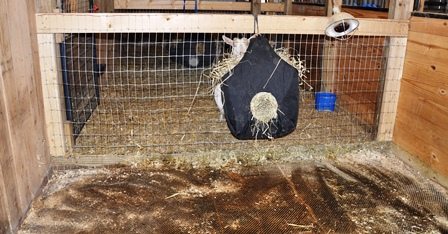
Dirt Flooring Beneath Goat Pens
Water and Electricity
There are many farms and homesteads without running water or electricity in the barn; however, having these amenities makes things much more convenient. Running water in the barn makes watering livestock and cleaning out the barn much easier. And electricity makes things like lights, web cameras, heated waterers, ventilation fans, clippers, milking machines, and electric fencing possible. Solar power is another option to consider for both electricity and hot water. Initially, solar power may be more expensive to install; however, over time it may pay for itself via saved energy costs.
When planning electrical wiring, remember that additional electrical features can be roughed in at the same time that the original wiring is done in a barn. That way, the wiring is already in place and you only need to add your fixtures when they become necessary. Be sure to plan ahead for things you hope to implement in the future.
Wondering what the webcams are really for? Well, when the goats are due to freshen, we’re able to monitor them via webcam (the goat in the photo below is due in two days).
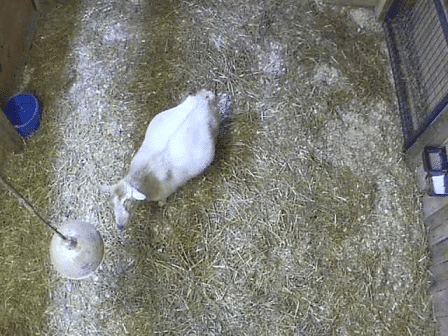
Overhead Camera View of Pregnant Goat
Livestock Accommodations
It’s a good idea to design barn pens or stalls specifically for the type of livestock you are planning to house. For example, stalls for larger animals like horses are typically built entirely of wood. When we initially built the barn, we had horse stalls built, not knowing that we’d eventually select dairy goats and chickens as livestock. The horse stalls were constructed entirely of wood, and while being good for horses, were not the best for goats.
Pens for smaller livestock like goats are better constructed from a material that the animals can see through (because they like to interact with each other). We eventually removed the wood and replaced it with woven wire fencing, and the goats were much happier. Cattle panels or woven wire fencing are often used to construct indoor pens, but depending on the animal type, woven wire fencing may not work well.
Some livestock species (like goats) may stand on the wire so frequently that it will eventually fatigue and break. When it does, it can badly injure an animal. We learned this when the fencing went through a goat’s hoof when it broke. Fortunately, we were in the barn when it happened, and we were able to immediately remove the fencing from her hoof (she made a full recovery and is fine). So, we now have sturdier panels built for the goat stalls, and they’re working out great (see the photo below). For more on our panel design for the goat pens, see Stronger and Configurable Goat Pens.
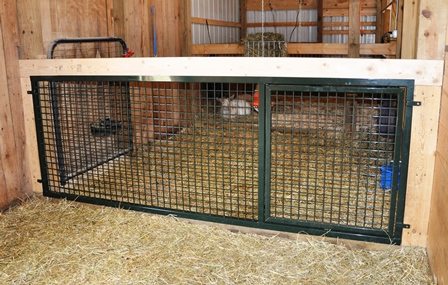
Powder Coated Steel Mesh Goat Pen Panels
If you don’t want to go with custom-built panels as we did, cattle panels are the standard, sturdier and safer choice for indoor pens for smaller livestock. One good way to learn what type of pens and materials work best for each animal species is to visit your county fairground livestock buildings. They typically have stalls or pens constructed to best suit each type of livestock.
Feed Storage in the Homestead Barn
The barn should be designed so that adequate quantities of hay and feed can easily be stored, kept dry, and protected from rodents. The second story of two-story barns makes an excellent area for hay storage. I think we messed up on this aspect – we should have built a two-story barn.
Most barns also have a separate room or area for feed storage. It’s important to store feed in a separate room or containers that the animals can’t get into or they may gorge on grain (which is often deadly) if they escape their stall or pen. Other amenities to consider in a feed storage room include storage cabinets for supplies and medicine, a sink, a refrigerator, and plenty of counter space.
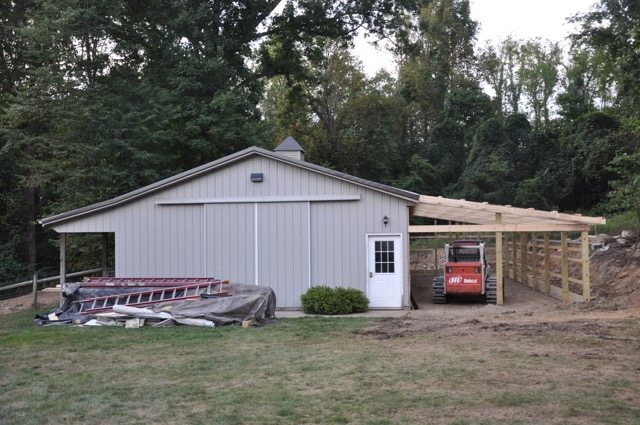
Barn Addition Under Construction
Manure Handling
When planning a barn to house livestock, keep in mind that manure and soiled bedding will need to be removed and hauled to compost piles (or somewhere) frequently and that it’s a lot easier to haul large quantities downhill than uphill. Also, be sure to design pens and stalls so that you can get in with equipment to remove soiled bedding and manure easily.
Do Your Homework Before Building Your Homestead Barn!
Unless you know exactly what will be done on your homestead, it’s probably not possible to design a forever perfect barn. However, it’s hard to over-emphasize how important planning the structure is. Make sure to carefully consider all aspects and give yourself maximum flexibility for whatever your homestead may become. Doing a good job of this upfront will result in an enjoyable barn you are proud of and save you lots of time, money, and effort later on.
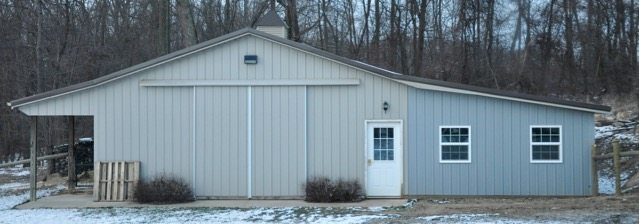
Completed Barn Addition – Front
Popular Types of Homestead Barns to Consider
There are many different styles of barns to choose from and the ones described below are all two-story options that are popular choices in the United States.
Bank Barn – as the name implies, these are barns that are built into the side of a hill (bank). This allows access to both the first and second-story levels from the ground level. It also helps to moderate temperatures in the barn. These barns provide two full stories of room plus a small loft but are significantly more expensive to build because of the foundational strength required. Livestock are often housed on the first level while equipment and hay are stored on the second level of this barn type.
Gable (A-Frame) Barn – these barns have roofs with an “A” shape and a steep pitch. The steep pitch helps prevent rainwater or snow from accumulating on the roof and causing water damage. The gable roof is one of the most affordable roof designs; however, it provides less loft space than other popular barn designs.
Gambrel Barn – gambrel barns have a roof with a double slope on each side. This type of barn offers the most loft space for hay storage which makes it a popular type of barn for livestock.
Monitor Barn – this type of barn has a portion of raised roof in the center of the barn. The raised roof removes some of the loft storage that would be available but allows windows to be installed below the raised roof thereby letting in lots of natural light.

Vicki says
Where did you get the green mesh gates/pen sides for your goat pens in the barn?
Lesa says
Hi Vicki, I wrote about those pens in a blog post here: https://www.betterhensandgardens.com/new-stronger-and-configurable-goat-pens/ And you can find where we had them made in the comments below. It’s a frequent question 🙂
Cori says
We are in the process of designing our homestead, very helpful article!
Lesa says
Hi Cori, I’m glad it was helpful and that you are “designing” your homestead – very smart!
Christina says
Hi! I loved your post! I am wondering though what type of utility cart you are using. When I googled it I came up with something that either looked like a wheel barrel or a golf cart. Which style do you use? If it is similar to the golf cart does it have a dumping feature so you don’t have to shovel it out? Thank you!
Lesa says
Hi Christina – that’s a good question, the utility cart makes all the difference in the world. It is similar to a golf cart and has a dumping feature. I wrote about it so you can check it out here: http://www.betterhensandgardens.com/new-electric-farm-utility-vehicle/
Margaret says
This is a great post. Very nicely laid out of the basic things you need to think of but also specific details and lessons you’ve learned. I love the idea of having stall gates reach all the way across the main aisle! I’m sure that’s saved a headache or two and makes it easy to move livestock around with fewer people! Great tip!
Lesa says
Thanks Margaret, I hope it’s helpful to lots of folks thinking about their first barn!